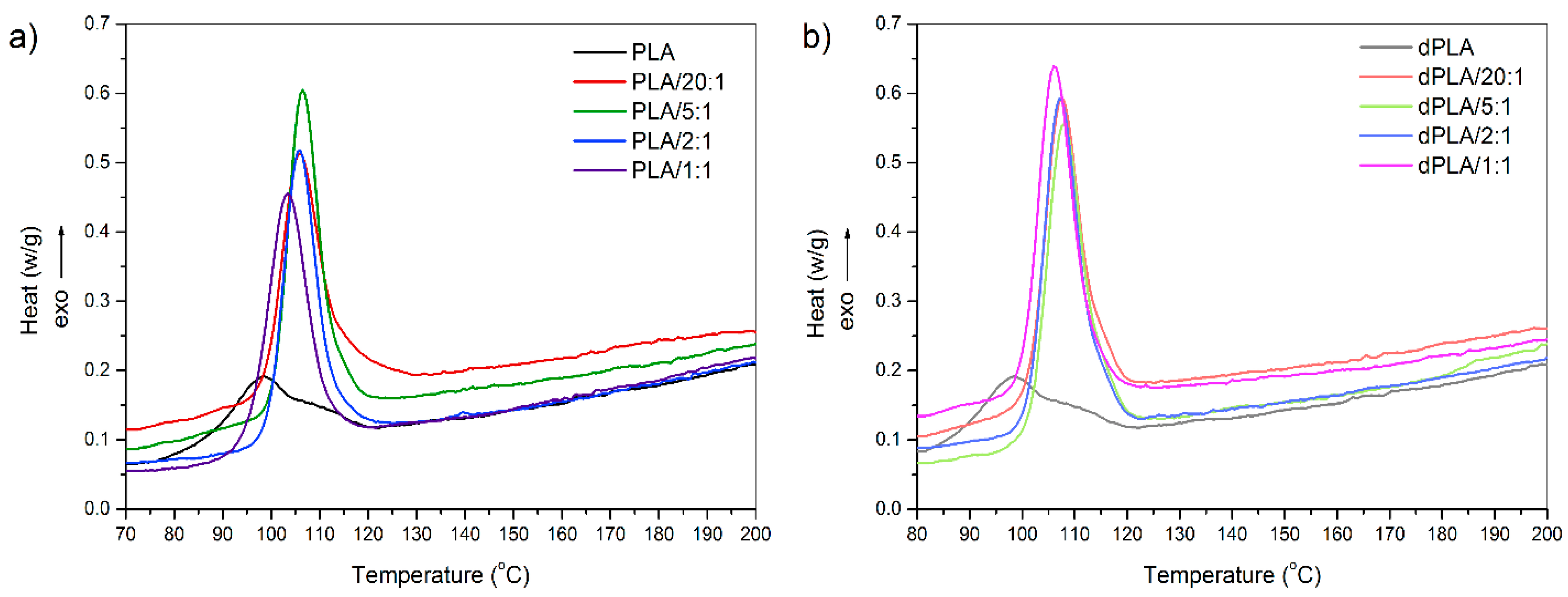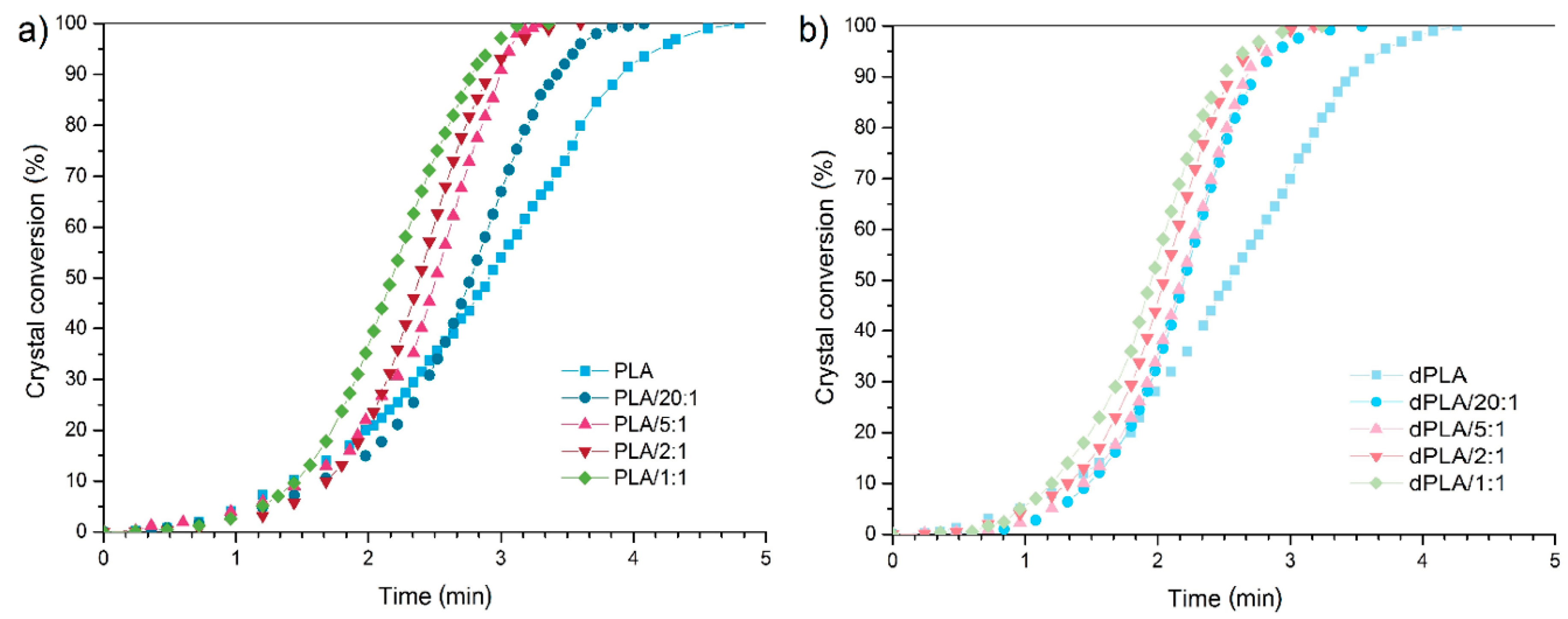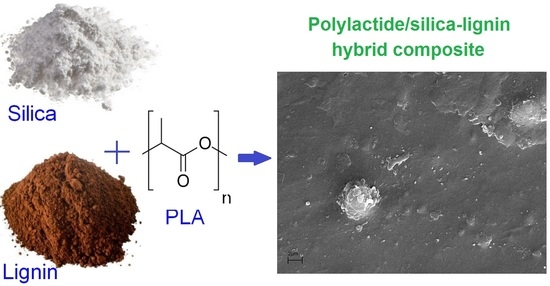Thermal and Mechanical Properties of Silica–Lignin/Polylactide Composites Subjected to Biodegradation
Abstract
:1. Introduction
2. Materials and Methods
2.1. Materials
2.2. Preparation of Silica–Lignin Hybrid Materials
2.3. Preparation of Polylactide/Silica–Lignin Hybrid Composites
2.4. Biodegradation of Composite Films
2.5. Characterization of Materials
2.5.1. Particle Size Distribution and Porous Properties of Fillers
2.5.2. Differential Scanning Calorimetry
2.5.3. Thermogravimetric Analysis
2.5.4. Colorimetric Analysis
2.5.5. Tensile Properties
2.5.6. Scanning Electron Microscopy
3. Results and Discussion
3.1. Characterization of Hybrid Fillers
3.2. Differential Scanning Analysis
3.3. Thermal Stability of Composites
3.4. Colorimetric Analysis
3.5. Mechanical Properties
3.6. Morphology of Films
4. Conclusions
Author Contributions
Funding
Conflicts of Interest
References
- Vink, E.T.H.; Rábago, K.R.; Glassner, D.A.; Gruber, P.R. Applications of life cycle assessment to NatureWorks™ polylactide (PLA) production. Polym. Degrad. Stabil. 2003, 80, 403–419. [Google Scholar] [CrossRef]
- Wen, X.; Lin, Y.; Han, C.; Zhang, K.; Ran, X.; Li, Y.; Dong, L. Thermomechanical and optical properties of biodegradable poly(l-lactide)/silica nanocomposites by melt compounding. J. Appl. Polym. Sci. 2009, 114, 3379–3388. [Google Scholar] [CrossRef]
- Bula, K.; Klapiszewski, Ł.; Jesionowski, T. A novel functional silica/lignin hybrid material as a potential bio-based polypropylene filler. Polym. Compos. 2015, 36, 913–922. [Google Scholar] [CrossRef]
- Jesionowski, T.; Zdarta, J.; Krajewska, B. Enzyme immobilization by adsorption: A review. Adsorption 2014, 20, 801–821. [Google Scholar] [CrossRef]
- Sadeghifar, H.; Cui, C.; Argyropoulos, D.S. Toward thermoplastic lignin polymers. Part 1. Selective masking of phenolic hydroxyl groups in kraft lignins via methylation and oxypropylation chemistries. Ind. Eng. Chem. Res. 2012, 51, 16713–16720. [Google Scholar] [CrossRef]
- Cui, C.; Sadeghifar, H.; Sen, S.; Argyropoulos, D.S. Toward thermoplastic lignin polymers. Part II: Thermal & polymer characteristics of kraft lignin & derivatives. BioResources 2013, 8, 864–886. [Google Scholar]
- Wyman, C.E. Aqueous Pretreatment of Plant Biomass for Biological and Chemical Conversion to Fuels and Chemicals; John Wiley & Sons: Hoboken, NJ, USA, 2013; ISBN 9780470972021. [Google Scholar]
- Toriz, G.; Denes, F.; Young, R.A. Lignin-polypropylene composites. Part 1: Composites from unmodified lignin and polypropylene. Polym. Compos. 2002, 23, 806–813. [Google Scholar] [CrossRef]
- Hasegawa, I.; Fujii, Y.; Yamada, K.; Kariya, C.; Takayama, T. Lignin-silica hybrids as precursors for silicon carbide. J. Appl. Polym. Sci. 1999, 73, 1321–1328. [Google Scholar] [CrossRef]
- Klapiszewski, Ł.; Rzemieniecki, T.; Krawczyk, M.; Malina, D.; Norman, M.; Zdarta, J.; Majchrzak, I.; Dobrowolska, A.; Czaczyk, K.; Jesionowski, T. Kraft lignin/silica-AgNPs as a functional material with antibacterial activity. Colloids Surf. B 2015, 134, 220–228. [Google Scholar] [CrossRef] [PubMed]
- Qu, Y.; Tian, Y.; Zou, B.; Zhang, J.; Zheng, Y.; Wang, L.; Li, Y.; Rong, C.; Wang, Z. A novel mesoporous lignin/silica hybrid from rice husk produced by a sol-gel method. Bioresour. Technol. 2010, 101, 8402–8405. [Google Scholar] [CrossRef] [PubMed]
- Strzemiecka, B.; Klapiszewski, Ł.; Jamrozik, A.; Szalaty, T.J.; Matykiewicz, D.; Sterzyński, T.; Voelkel, A.; Jesionowski, T. Physicochemical characterization of functional lignin-silica hybrid fillers for potential application in abrasive tools. Materials 2016, 9, 517. [Google Scholar] [CrossRef] [PubMed]
- Zhang, R.; Xiao, X.; Tai, Q.; Huang, H.; Yang, J.; Hu, Y. Preparation of lignin-silica hybrids and its application in intumescent flame-retardant poly(lactic acid) system. High Perform. Polym. 2012, 24, 738–746. [Google Scholar] [CrossRef]
- Strzemiecka, B.; Klapiszewski, Ł.; Matykiewicz, D.; Voelkel, A.; Jesionowski, T. Functional lignin-SiO2 hybrids as potential fillers for phenolic binders. J. Adhes. Sci. Technol. 2016, 30, 1031–1048. [Google Scholar] [CrossRef]
- Mohanty, A.K.; Misra, M.; Hinrichsen, G. Biofibres, biodegradable polymers and biocomposites: An overview. Macromol. Mater. Eng. 2000, 276–277, 1–24. [Google Scholar] [CrossRef]
- Jain, J.P.; Yenet Ayen, W.; Domb, A.J.; Kumar, N. Biodegradable Polymers in Drug Delivery. In Biodegradable Polymers in Clinical Use and Clinical Development; Domb, A.J., Kumar, N., Ezra, A., Eds.; John Wiley & Sons: Hoboken, NJ, USA, 2011; pp. 1–58. ISBN 9780470424759. [Google Scholar]
- Petinakis, E.; Liu, X.; Yu, L.; Way, C.; Sangwan, P.; Dean, K.; Bateman, S.; Edward, G. Biodegradation and thermal decomposition of poly(lactic acid)-based materials reinforced by hydrophilic fillers. Polym. Degrad. Stabil. 2010, 95, 1704–1707. [Google Scholar] [CrossRef]
- Fukushima, K.; Abbate, C.; Tabuani, D.; Gennari, M.; Camino, G. Biodegradation of poly(lactic acid) and its nanocomposites. Polym. Degrad. Stabil. 2009, 94, 1646–1655. [Google Scholar] [CrossRef]
- Liu, Y.; Chen, W.; Kim, H.-I. Synthesis, characterization, and hydrolytic degradation of polylactide/poly(ethylene glycol)/nano-silica composite films. J. Macromol. Sci. Part A 2012, 49, 348–354. [Google Scholar] [CrossRef]
- Grząbka-Zasadzińska, A.; Klapiszewski, Ł.; Bula, K.; Jesionowski, T.; Borysiak, S. Supermolecular structure and nucleation ability of polylactide-based composites with silica/lignin hybrid fillers. J. Therm. Anal. Calorim. 2016, 126, 263–275. [Google Scholar] [CrossRef] [Green Version]
- Borysiak, S.; Klapiszewski, Ł.; Bula, K.; Jesionowski, T. Nucleation ability of advanced functional silica/lignin hybrid fillers in polypropylene composites. J. Therm. Anal. Calorim. 2016, 126, 251–262. [Google Scholar] [CrossRef] [Green Version]
- Klapiszewski, Ł.; Bula, K.; Sobczak, M.; Jesionowski, T. Influence of processing conditions on the thermal stability and mechanical properties of PP/silica-lignin composites. Int. J. Polym. Sci. 2016, 1627258, 1–9. [Google Scholar] [CrossRef]
- Garlotta, D. A literature review of poly(lactic acid). J. Polym. Environ. 2001, 9, 63–84. [Google Scholar] [CrossRef]
- Sharma, G.; Bala, R. Digital Color Imaging Handbook; CRC Press: Boca Raton, FL, USA, 2002; ISBN 9780849309007. [Google Scholar]
- Rahman, M.M.; Afrin, S.; Haque, P.; Islam, M.M.; Islam, M.S.; Gafur, M.A. Preparation and characterization of jute cellulose crystals-reinforced poly(L-lactic acid) biocomposite for biomedical applications. Int. J. Chem. Eng. 2014, 842147, 1–7. [Google Scholar] [CrossRef]
- Anwer, M.A.S.; Naguib, H.E.; Celzard, A.; Fierro, V. Comparison of the thermal, dynamic mechanical and morphological properties of PLA-Lignin & PLA-Tannin particulate green composites. Compos. Part B Eng. 2015, 82, 92–99. [Google Scholar] [CrossRef]
- Valapa, R.; Hussain, S.; Iyer, P.; Pugazhenthi, G.; Katiyar, V. Influence of graphene on thermal degradation and crystallization kinetics behaviour of poly(lactic acid). J. Polym. Res. 2015, 22, 1–14. [Google Scholar] [CrossRef]
- Zimmermann, M.V.G.; Brambilla, V.C.; Brandalise, R.N.; Zattera, A.J. Observations of the effects of different chemical blowing agents on the degradation of poly(lactic acid) foams in simulated soil. Mater. Res. 2013, 16, 1266–1273. [Google Scholar] [CrossRef] [Green Version]
- Hakkarainen, M.; Albertsson, A.-C.; Karlsson, S. Weight losses and molecular weight changes correlated with the evolution of hydroxyacids in simulated in vivo degradation of homo- and copolymers of PLA and PGA. Polym. Degrad. Stabil. 1996, 52, 283–291. [Google Scholar] [CrossRef]
- Murariu, M.; Dechief, A.-L.; Ramy-Ratiarison, R.; Paint, Y.; Raquez, J.-M.; Dubois, P. Recent advances in production of poly(lactic acid) (PLA) nanocomposites: A versatile method to tune crystallization properties of PLA. Nanocomposites 2015, 1, 71–82. [Google Scholar] [CrossRef]
- Niaounakis, M. Biopolymers: Applications and Trends; Elsevier Inc.: Amsterdam, The Netherlands, 2015; ISBN 978-0-323-35399-1. [Google Scholar]
- Kopinke, F.D.; Remmler, M.; Mackenzie, K.; Möder, M.; Wachsen, O. Thermal decomposition of biodegradable polyesters—II. Poly(lactic acid). Polym. Degrad. Stabil. 1996, 53, 329–342. [Google Scholar] [CrossRef]
- Pinto, A.M.; Gonçalves, C.; Gonçalves, I.C.; Magalhães, F.D. Effect of biodegradation on thermo-mechanical properties and biocompatibility of poly(lactic acid)/graphene nanoplatelets composites. Eur. Polym. J. 2016, 85, 431–444. [Google Scholar] [CrossRef]
- Gordobil, O.; Delucis, R.; Egüés, I.; Labidi, J. Kraft lignin as filler in PLA to improve ductility and thermal properties. Ind. Crop. Prod. 2015, 72, 46–53. [Google Scholar] [CrossRef]
- Costes, L.; Laoutid, F.; Aguedo, M.; Richel, A.; Brohez, S.; Delvosalle, C.; Dubois, P. Phosphorus and nitrogen derivatization as efficient route for improvement of lignin flame retardant action in PLA. Eur. Polym. J. 2016, 84, 652–667. [Google Scholar] [CrossRef]
- Hiltunen, E.; Alvila, L.; Pakkanen, T.T. Characterization of Brauns’ lignin from fresh and vacuum-dried birch (Betula pendula) wood. Wood Sci. Technol. 2006, 40, 575. [Google Scholar] [CrossRef]
- Wang, J.; Deng, Y.; Qian, Y.; Qiu, X.; Ren, Y.; Yang, D. Reduction of lignin color via one-step UV irradiation. Green Chem. 2016, 18, 695–699. [Google Scholar] [CrossRef]
- Karamanlioglu, M.; Robson, G.D. The influence of biotic and abiotic factors on the rate of degradation of poly(lactic) acid (PLA) coupons buried in compost and soil. Polym. Degrad. Stabil. 2013, 98, 2063–2071. [Google Scholar] [CrossRef]
- Fu, S.Y.; Feng, X.Q.; Lauke, B.; Mai, Y.W. Effects of particle size, particle/matrix interface adhesion and particle loading on mechanical properties of particulate-polymer composites. Compos. Part B Eng. 2008, 39, 933–961. [Google Scholar] [CrossRef]
- Omar, M.F.; Akil, H.M.; Ahmad, Z.A. Particle size—Dependent on the static and dynamic compression properties of polypropylene/silica composites. Mater. Des. 2013, 45, 539–547. [Google Scholar] [CrossRef]
- Li, J.; He, Y.; Inoue, Y. Thermal and mechanical properties of biodegradable blends of poly(l-lactic acid) and lignin. Polym. Int. 2003, 52, 949–955. [Google Scholar] [CrossRef]
- Chung, Y.-L.; Olsson, J.V.; Li, R.J.; Frank, C.W.; Waymouth, R.M.; Billington, S.L.; Sattely, E.S. A renewable lignin–lactide copolymer and application in biobased composites. ACS Sustain. Chem. Eng. 2013, 1, 1231–1238. [Google Scholar] [CrossRef]
- Zhu, J.; Xue, L.; Wei, W.; Mu, C.; Jiang, M.; Zhou, Z. Modification of lignin with silane coupling agent to improve the interface of poly (L-lactic) acid/lignin composites. BioResources 2015, 10, 4315–4325. [Google Scholar] [CrossRef]
- Gajjar, C.R.; King, M.W. Resorbable Fiber-Forming Polymers for Biotextile Applications; Springer International Publishing: New York, NY, USA, 2014; ISBN 978-3-319-08304-9. [Google Scholar]
- Fukushima, K.; Tabuani, D.; Abbate, C.; Arena, M.; Ferreri, L. Effect of sepiolite on the biodegradation of poly(lactic acid) and polycaprolactone. Polym. Degrad. Stabil. 2010, 95, 2049–2056. [Google Scholar] [CrossRef]
- Lyu, S.; Untereker, D. Degradability of polymers for implantable biomedical devices. Int. J. Mol. Sci. 2009, 10, 4033–4065. [Google Scholar] [CrossRef] [PubMed]
- Spiridon, I.; Leluk, K.; Resmerita, A.M.; Darie, R.N. Evaluation of PLA-lignin bioplastics properties before and after accelerated weathering. Compos. Part B Eng. 2015, 69, 342–349. [Google Scholar] [CrossRef]
- Cicogna, F.; Coiai, S.; Monte, C.D.; Spiniello, R.; Fiori, S.; Franceschi, M.; Braca, F.; Cinelli, P.; Fehri, S.M.K.; Lazzeri, A.; et al. Poly(lactic acid) plasticized with low-molecular-weight polyesters: Structural, thermal and biodegradability features. Polym. Int. 2017, 66, 761–769. [Google Scholar] [CrossRef]
- Yu, L.; Liu, H.; Xie, F.; Chen, L.; Li, X. Effect of annealing and orientation on microstructures and mechanical properties of polylactic acid. Polym. Eng. Sci. 2008, 48, 634–641. [Google Scholar] [CrossRef]
- Fengel, D.; Wegener, G. Wood: Chemistry, Ultrastructure, Reactions; De Gruyter: Berlin, Germany, 1983; ISBN 10. [Google Scholar]





| Sample | Particle Size Distribution Range (nm) | Mean Size of Pores (nm) |
|---|---|---|
| Silica | 39–71; 1440–4800 | 3.9 |
| Lignin | 1720–5560 | 12.3 |
| Filler 20:1 | 39–79; 1720–4800 | 4.1 |
| Filler 5:1 | 68–122; 1990–4800 | 4.8 |
| Filler 2:1 | 79–220; 1720–4800 | 5.5 |
| Filler 1:1 | 91–220; 1990–5560 | 8.0 |
| Sample | Tm (°C) | Tc (°C) | Xc (%) | t0.5 (min) |
|---|---|---|---|---|
| PLA | 177.0 | 98.0 | 60 | 2.9 |
| PLA/20:1 | 177.4 | 105.9 | 47 | 2.8 |
| PLA/5:1 | 176.9 | 106.6 | 48 | 2.5 |
| PLA/2:1 | 175.9 | 105.8 | 51 | 2.4 |
| PLA/1:1 | 174.5 | 103.5 | 52 | 2.2 |
| dPLA | 176.8 | 98.1 | 66 | 2.5 |
| dPLA/20:1 | 177.0 | 107.6 | 49 | 2.2 |
| dPLA/5:1 | 177.0 | 107.9 | 51 | 2.2 |
| dPLA/2:1 | 176.9 | 107.2 | 55 | 2.1 |
| dPLA/1:1 | 175.9 | 106.1 | 57 | 2.0 |
| Sample | 5% wt. Loss | 15% wt. Loss | 50% wt. Loss |
|---|---|---|---|
| Temperature (°C) | |||
| PLA | 326 | 337 | 361 |
| PLA/20:1 | 314 | 331 | 359 |
| PLA/5:1 | 303 | 326 | 350 |
| PLA/2:1 | 314 | 332 | 358 |
| PLA/1:1 | 281 | 291 | 315 |
| dPLA | 314 | 326 | 345 |
| dPLA/20:1 | 314 | 331 | 360 |
| dPLA/5:1 | 303 | 325 | 350 |
| dPLA/2:1 | 314 | 332 | 356 |
| dPLA/1:1 | 280 | 321 | 345 |
| Sample | YM (GPa) | TS (MPa) | EB (%) |
|---|---|---|---|
| PLA | 2.08 ± 0.12 | 52.28 ± 5.59 | 46.33 ± 17.17 |
| PLA/20:1 | 1.15 ± 0.18 | 27.94 ± 1.84 | 10.23 ± 1.20 |
| PLA/5:1 | 1.33 ± 0.13 | 30.42 ± 2.56 | 20.37 ± 7.20 |
| PLA/2:1 | 1.34 ± 0.21 | 38.17 ± 1.08 | 5.26 ± 1.38 |
| PLA/1:1 | 1.12 ± 0.18 | 30.07 ± 3.14 | 3.67 ± 0.79 |
| dPLA | 2.11 ± 0.55 | 52.93 ± 2.53 | 12.30 ± 3.75 |
| dPLA/20:1 | 0.67 ± 0.11 | 21.30 ± 0.25 | 1.75 ± 0.04 |
| dPLA/5:1 | 0.37 ± 0.15 | 13.39 ± 6.12 | 2.01 ± 0.68 |
| dPLA/2:1 | 0.29 * | 7.58 * | 1.67 * |
| dPLA/1:1 | 0.14 * | 3.17 * | 1.41 * |
© 2018 by the authors. Licensee MDPI, Basel, Switzerland. This article is an open access article distributed under the terms and conditions of the Creative Commons Attribution (CC BY) license (http://creativecommons.org/licenses/by/4.0/).
Share and Cite
Grząbka-Zasadzińska, A.; Klapiszewski, Ł.; Borysiak, S.; Jesionowski, T. Thermal and Mechanical Properties of Silica–Lignin/Polylactide Composites Subjected to Biodegradation. Materials 2018, 11, 2257. https://doi.org/10.3390/ma11112257
Grząbka-Zasadzińska A, Klapiszewski Ł, Borysiak S, Jesionowski T. Thermal and Mechanical Properties of Silica–Lignin/Polylactide Composites Subjected to Biodegradation. Materials. 2018; 11(11):2257. https://doi.org/10.3390/ma11112257
Chicago/Turabian StyleGrząbka-Zasadzińska, Aleksandra, Łukasz Klapiszewski, Sławomir Borysiak, and Teofil Jesionowski. 2018. "Thermal and Mechanical Properties of Silica–Lignin/Polylactide Composites Subjected to Biodegradation" Materials 11, no. 11: 2257. https://doi.org/10.3390/ma11112257






